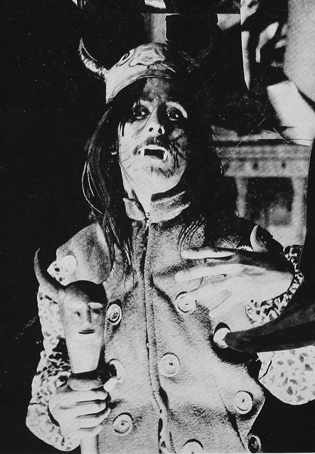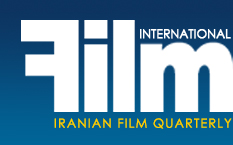|
Reflections on The Hunchback's Night, 45 years later
Actors and Conspiracies
by Ramin S. Khanjani
|
 The year 1965 was a watershed for the Iranian cinema with the movie called Qarun’s Treasure emerging as a phenomenon, setting a new record in domestic film sales that many commercial filmmakers would dream of. It was basically an upbeat melodrama hugely influenced by the popular Indian cinema which effectively exploited all the familiar formulas that appeal to the average cinemagoers and deserves to be called the pinnacle of the Iranian commercial cinema. However just one year earlier, when the thriving commercial movie industry was at its acme, another movie was screened which also occupies an important position in the history of the Iranian cinema, albeit for a totally different reason. The film entitled The Hunchback's Night (1964) was the third movie of its director and one of the first attempts in establishment of an independent and more serious trend of filmmaking in the Iranian cinema. Qaysar (1968) and The Cow (1968) have yet to be made a few years later to officially start the new wave of the Iranian cinema as a discernable current. Before this current, there were a handful of individual movies barely noticeable in the context of extremely market-minded Iranian cinema industry and this movie was one of those sparkling attempts against the dark. The year 1965 was a watershed for the Iranian cinema with the movie called Qarun’s Treasure emerging as a phenomenon, setting a new record in domestic film sales that many commercial filmmakers would dream of. It was basically an upbeat melodrama hugely influenced by the popular Indian cinema which effectively exploited all the familiar formulas that appeal to the average cinemagoers and deserves to be called the pinnacle of the Iranian commercial cinema. However just one year earlier, when the thriving commercial movie industry was at its acme, another movie was screened which also occupies an important position in the history of the Iranian cinema, albeit for a totally different reason. The film entitled The Hunchback's Night (1964) was the third movie of its director and one of the first attempts in establishment of an independent and more serious trend of filmmaking in the Iranian cinema. Qaysar (1968) and The Cow (1968) have yet to be made a few years later to officially start the new wave of the Iranian cinema as a discernable current. Before this current, there were a handful of individual movies barely noticeable in the context of extremely market-minded Iranian cinema industry and this movie was one of those sparkling attempts against the dark.
The year 1965 was a watershed for the Iranian cinema with the movie called Qarun’s Treasure emerging as a phenomenon, setting a new record in domestic film sales that many commercial filmmakers would dream of. It was basically an upbeat melodrama hugely influenced by the popular Indian cinema which effectively exploited all the familiar formulas that appeal to the average cinemagoers and deserves to be called the pinnacle of the Iranian commercial cinema. However just one year earlier, when the thriving commercial movie industry was at its acme, another movie was screened which also occupies an important position in the history of the Iranian cinema, albeit for a totally different reason. The film entitled The Hunchback's Night (1964) was the third movie of its director and one of the first attempts in establishment of an independent and more serious trend of filmmaking in the Iranian cinema. Qaysar (1968) and The Cow (1968) have yet to be made a few years later to officially start the new wave of the Iranian cinema as a discernable current. Before this current, there were a handful of individual movies barely noticeable in the context of extremely market-minded Iranian cinema industry and this movie was one of those sparkling attempts against the dark.
Its director, Farrokh Ghaffari, had lived abroad for long years, where he was engaged in cultural and cinema activities, though he had not studied cinema academically. Although coming from an aristocrat family, his first feature Downtown (1958) was an exercise in a realistic and credible portrayal of the lower strata of the society and the poor neighborhoods. However, this exercise in realism lead to banning of the movie after a brief screening, and it wasn’t screened again until some cuts and additions. The film was rescreened under a new title with director’s name omitted by his own request. Ghaffari’s next movie was a light comedy about a young couple who undergo a gender change just before their wedding. This film called Who Is the Bride? (1959) proved unsuccessful with audience and critics alike. So, after a brief hiatus in making features, Ghaffari teamed up with Jalal Moqaddam who had written the script for the Downtown and later a director in his own rights and together they worked on the script for The Hunchback's Night.
The movie is an adaptation of long tale from “One Thousand Nights and One Night” which recounts the story of Caliph’s hunchback jester who is found ostensibly dead and the people who stumble upon him want to get rid of his body. For some reasons, Ghaffari had brought the story against a contemporary setting. In the movie, the hunchback is the leading member of a traditional theater troupe. One night, when they are invited to perform in a private party, the host lady secretly passes a list of names to the hunchback and asks him to take it to some important guy. Seemingly the people in the list are involved in an illegal activity and so the police shouldn’t get their hands on it. On their way back home, peers of hunchback banter with him by putting a huge piece of food in his mouth and in just a few moments, find him motionless. Distressed by the harrowing result of their foolish jest, they desperately decide to take him to a doctor. While searching for a doctor’s office, the actors notice the police are patrolling the area and out of their fear, leave the body. The people who find the corpse at their doorstep are hairdressers involved in smuggling as well and have to leave the country in a few hours, so they struggle to dump it. The delivery of the corpse gets other people involved as well, but eventually, the police recover the body, arrest the criminals and we are told that hunchback had died of a heart attack and therefore his unintentional murder is ruled out.
SUBSCRIBE
[Page: 66]
|
|
|
|
|
President & Publisher
Massoud Mehrabi
Editors:
Sohrab Soori
Translators:
Sohrab Soori
Behrouz Tourani
Zohreh Khatibi
Saeed Khamoush
Contributors
Saeed Ghotbizadeh
Mehrzad Danesh
Advertisements
Mohammad Mohammadian
Art Director
Babak Kassiri
Ad Designers
Amir Kheirandish
Hossein Kheirandish
Cover Design
Alireza Amakchi
Correspondents
E.Emrani & M. Behraznia (Germany)
Mohammad Haghighat (France)
A. Movahed & M. Amini (Italy)
Robert Richter (Switzerland)
F. Shafaghi (Canada)
B. Pakzad (UAE)
H. Rasti (Japan)
Print Supervisors
Shad-Rang
Noghreh-Abi
Gol-Naghsh
Subscription & Advertising Sales
Address: 10, Sam St., Hafez Ave., TEHRAN, IRAN
Phone: +98 21 66722444
Fax: +98 21 66718871
info@film-magazine.com
Copyright: Film International
© All rights reserved,
2023, Film International
Quarterly Magazine (ISSN 1021-6510)
Editorial Office: 5th Floor, No. 12
Sam St., Hafez Ave., Tehran 11389, Iran
*
All articles represent views of their
authors and not necessarily
those of the editors
|
|
|

